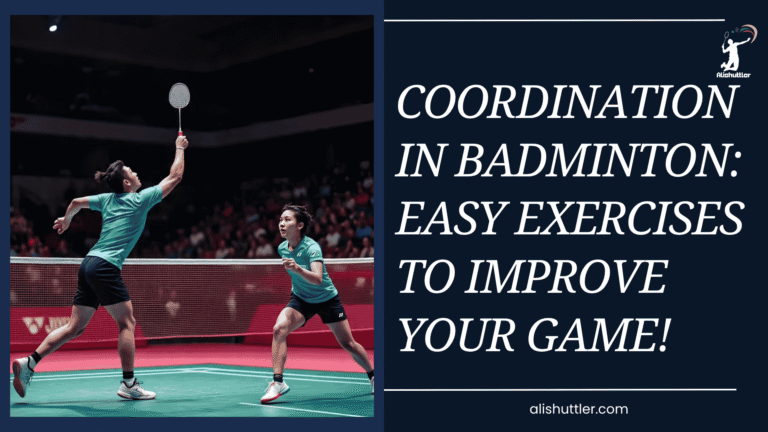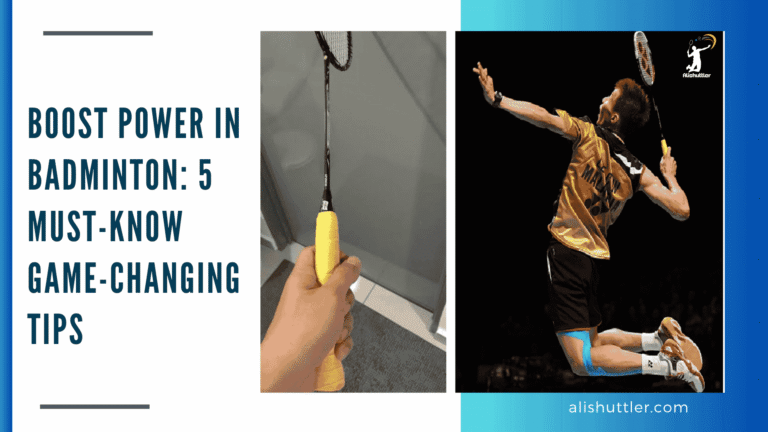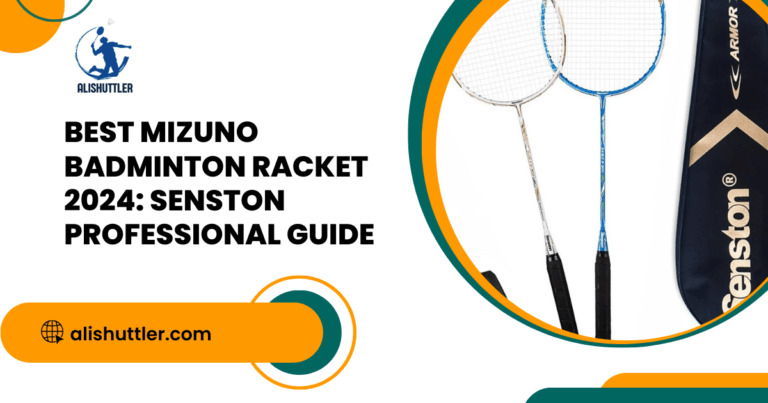Badminton techniques for smashing refer to the proper utilization of body, grip, and timing for a quick, powerful shot. Smashing in badminton requires a strong wrist snap, quick footwork, and that perfect angle to drive the shuttlecock down fast.
Players typically employ specialized grips and arm movements for optimal power. Learning these skills aids you score points and maintain pressure on your opponents.
The below main body deconstructs each step and provides easy advice.
The Smash Foundation

Great smashing in badminton begins with the right fundamentals. The grip, stance and swing all create a solid foundation of power and control. Master these components and you’ll be able to hit blistering smashes from anywhere on the court. Every step counts, and minor adjustments in grip or body angle can have a significant impact.
Grip
Getting a handle on your grip is essential for power and control on your smashes. Experiment with forehand and backhand grips so you’ll be able to utilize whichever is best for the shot. Some players stick with the forehand grip for overhead smashes, others flip to backhand for lightning returns close to the body.
Keeping your grip style loose allows you to respond to any shuttle positioning.
- Pinch the handle with your thumb and index finger, don’t squeeze.
- Maintain a half-inch to one inch space between your palm and the handle so that your wrist can move.
- Lay your middle finger slack against the handle for additional control.
- Avoid wrapping all fingers tightly, which restricts motion.
A firm yet loose grip allows you to swing hard without sacrificing racket control. Because if you grip too tight, your wrist can’t snap. If too loose, you run the risk of the racket slipping. Grip training helps a ton.
Try squeezing a rubber ball or wrist curls with light weights. Stronger hands and wrists = harder smashes, lesser fatigue.
Stance
Begin with a neutral position to maintain flexibility. Position yourself with feet shoulder-width apart, knees slightly bent. This configuration provides you both the power to smash and the agility to react for the follow-up.
Lean forward onto the balls of your feet. This minor adjustment goes a long way. It allows you to dash fast in any direction, which is vital for swift smash after-rally sprints.
ALWAYS turn your body towards the incoming shuttle. By lining up your chest and hips with the shuttle you transfer more force from your legs and core into your arm. A proper stance doesn’t just make you smash harder, it reduces injury risk as well.
Swing
A good smash swing is fluid and fast. Start with your racket behind your head, elbow cocked. As you swing, snap shoulder, arm and wrist all the way forward. Complete your swing, keeping your racket aimed at the direction you want the shuttle to go.
Practice slow-mo swings first. This allows you to pay attention to your technique and timing. When your form feels good, increase your swing speed.
Coach or partner drills can help you discover the appropriate cadence. Perhaps count aloud or swing to a rhythm. This develops muscle memory, so your body recalls the correct motion even in quick matches.
Mastering Smash Mechanics

Smashing is more than just whipping your arm. Top players use the entire body as one, converting each segment into a link in a powerful chain. This method, known as the kinetic chain, begins from the ground and ends at the racket head, with every link counting. When to unleash this chain, how to weight transfer, rotate your torso, and loosen your arm and wrist can help you punch up hi and hard while staying in control.
1. The Kinetic Chain
The kinetic chain starts with the feet driving off the ground, and moves up through the legs, hips, torso, shoulder, arm and eventually the wrist and racket. Each segment contributes velocity and impact. A quality smash employs the legs to initiate the push, the core to twist, and the arm and wrist to snap the racket.
Think of how a sprinter pushes off with his legs and then swings his arms—it’s a full body motion. When practicing, segment the chain. Squats and lunges will develop that leg strength. Planks and twists assist the core. Shadow swings, slow at first, allow you to sense each link in the chain.
Use video to observe whether your body moves in the correct sequence, and ensure your body aligns straight from foot to racket to avoid energy loss.
2. Weight Transfer
A firm smash requires you to transfer your weight from the back to the front foot during your swing. This shift keeps you quick and gives you additional force. Doing shadow drills that make you step in and hit, or even just working on footwork, can help this move feel natural.
Your legs are a secret weapon — if you push off your legs, you’ll be able to smash harder without relying on brute arm force. Drills where you jump or lunge forward BEFORE a smash can help. Never lose your balance, otherwise you’ll lose your footing or control after the hit.
3. Torso Rotation
Torso Rotation – Turn your body as you smash to add torque to your shot. Initiate the turn from your hips and allow your shoulders to take over, so that your upper body unwinds into the shot. That twist is a source of much of the smash’s speed.
Core tightening keeps you stable, so you don’t fall off balance. Rotational drills, such as swinging a medicine ball or twisting with a resistance band, can train your body to use this move. The more your shoulders initiate the turn, the quicker racket sweeps through the ball and the more powerful smash.
4. Arm Pronation
Pronation is the forearm twist that turns the palm down at impact. This accelerates the racket, enabling you to fire off harder smashes. The wrist assists in steering this twist, increasing shot precision.
Practice slow swings with an emphasis on the forearm turn. Play around with smacking shuttles with only your forearm and wrist to develop the sense. Combine pronation with the rest of the technique for optimal results.
5. Wrist Snap
A solid wrist snap imparts the smash its final acceleration. Keep your wrist loose through your swing, then snap it forward just at impact. Use drills with light rackets or even just your hand to develop the proper sensation.
Timing is everything–snap too early or too late and you lose power. The wrist should remain loose to allow for rapid movement. It’s this snap that allows top players to generate smashes that dip quickly.
Smash Variations

Smash variations in badminton provide you with additional methods to put the game in motion and keep opponents on their toes. Smash variations can help spice up the pace and angle of rallies. Players can hone these skills in practice, then apply them in matches to respond to any circumstance and locate the perfect moment to strike.
The Jump Smash
The jump smash introduces a vertical dimension to the attack, allowing players to strike from above and impart more power on the shot. To execute this smash effectively, players require strong legs for a fast lift-off, precise timing to connect with the shuttle at its summit, and good landing skills to remain poised for the next shot or swift return.
Most elite players employ the jump smash on defensive clears or lifts that hang high, enabling them to smash the shuttle down fast and steep.
| Aspect | Key Points |
|---|---|
| Timing | Jump as shuttle starts to fall, reach at top point. |
| Leg Strength | Build with squats, lunges, and plyometric drills. |
| Landing | Land on both feet, knees bent, ready for next shot. |
Concentrating on leg workouts increases jump height and smash power. Land safely to maintain balance and reduce injury.
The Half Smash
Half smash are rapid and can catch out an opponent expecting a full smash. It employs less power but rushes the shuttle down with a lower trajectory. The key is to manipulate wrist speed and racket angle, so the shuttle stays low but skitters with velocity.
This shot typically plays best when you’re looking to create an opening, as opposed to banging a straight winner. Practice by attempting various angles and speeds. For instance, try to place the shuttle to the sidelines or just past the service line to unsettle the defender.
Experiment with the half smash following a long rally, when your opponent is deep or off to the side. Employ it in these moments, and you can compel a tepid response, creating an opportunity for a more powerful strike.
The Slice Smash
Slice smashes impart spin and cause the shuttle to fly in a curve. This can disrupt an opponent’s timing and make it difficult to predict where the shuttle will land. The key is tilting the racket face at impact, brushing the shuttle instead of hitting it flat.
This shot serves you best when you are trying to keep the other player off balance. With practice, players become skilled at targeting the slice smash to either corner. These controls prove handy when dealing with speedy competitors who are strong against straight smashes.
By interspersing slice smashes, you can create openings and induce errors.
Practical Application
Include these smashes in your training schedule. Try ‘em all out in some game-like drills. Check out top-level matches for additional examples. Each smash comes into its own at different moments—choose wisely to make your assault effective!
Strategic Smashing

Smashing in badminton is not merely about raw power. A strategically smacked shot can burst through even the tightest defenses and capture crucial points. The best players employ careful strategy, not brute strength, to position their shots where they’ll cause the most damage.
Target Selection
Clever hitters choose their pitches, not just swing hard. Opting for the sidelines or deep corners makes returns more difficult. When you see your opponent leaning too far to one side or standing flat-footed around the service line, you can target the gap they’ve left. That keeps them guessing and on the move.
In practice, you can create drills by positioning shuttle tubes or cones at various locations on the court. Aim for these goals at varying angles and lengths. This trains you to develop more control and learn how to make quick decisions about where to hit in a real match.
If you always smash to the same spot, your opponent will catch on quickly. Mixing it up keeps you on your toes.
Deceptive Cues
It’s a trick worth mastering. Twisting your stance or grip right before you swing can throw your opponent’s read off. For instance, you could position yourself for a drop shot, but then deliver a quick smash. Feints — a little hesitation, or a fake swing — can disrupt your adversary’s flow and induce blunders.
It’s useful to watch some high-level matches on video. Observe how elite athletes employ subtle shifts in shoulder or wrist movement to fool their adversaries. Practicing in front of a mirror or recording yourself can reveal whether or not you’re telegraphing your shots.
Following games, look over your trick plays. Did your opposition shuffle the incorrect direction? Did they blink? This data can assist you in making your smashes even more unpredictable.
Post-Smash Recovery
A powerful smash is no good if you’re not prepared for the next volley. Quick recovery equates to having your feet back to an equilibrium position around the center of the court. This allows you to respond quickly, regardless if the shuttle returns high or low.
Quick footwork drills can help. For instance, after smashing, push yourself back into a ready position before the shuttle is returned. Over time, this builds muscle memory.
Study your matches to see if you’re sluggish getting up after a smash, to identify what patterns stall you.
Key Considerations
- Always watch your opponent’s court position before smashing.
- Mix up your target spots to avoid being predictable.
- Use body movement and feints for deceptive play.
- Go for quick-poke attacks to maintain the heat on your adversary.
Correcting Errors
Correcting smash errors in badminton requires a keen focus on timing, force and precision. By dissecting each aspect, players can identify where things derail and focus on actionable solutions.
Timing Issues
Most players miss their smash due to timing issues. If your swing, footwork and shuttle contact aren’t in unison, your smash will lack power and precision.
An effective technique is to pay attention to the cadence of your entire body. For instance, attempt hitting smashes at a fixed rhythm, synchronizing the swing with foot work. Practice against a partner does help, as you can simulate game speed and adapt to various shuttle heights.
Recording practice sessions allows you to slow down the action and identify if your swing gets an early start, or your feet fall behind. Rhythm drills, such as shadow swings accompanied by a metronome app, develop timing and ensure movements stay synchronized. These techniques cause each smash’s timing to be more consistent.
Power Leaks
Power leaks tend to pop up during when players fail to effectively transfer their energy from the legs through the core to the arm and racket. If any link in this chain snaps, the smash dissipates.
To find leaks, test critical components of your swing. Is your non-racket arm assisting with balance? Are you getting a complete shoulder turn? These are popular places for power to go.
Coach feedback — or even video review — could reveal if the wrist snaps late, or if the body weight doesn’t shift forward. Here are some typical power leak points and matching drills:
| Power Leak Area | Drill to Fix |
|---|---|
| Weak shoulder turn | Shadow swings, focus on rotation |
| Poor weight shift | Step-in smash drill |
| Late wrist snap | Isolate wrist flicks |
| Unused non-racket arm | Balance drills |
Attempt each drill, focusing on the flow of energy from beginning to end.
Poor Accuracy
Precision issues can drag down even the quickest smashes. Not just brute force, but being able to reach little goals over and over again.
Add accuracy drills to your regimen. Use tape to mark targets on the court. Take practice hits to the corners or just inside the service lines. Work under pressure — time yourself or play accuracy games with a partner.
This acclimatizes you to targeting when it matters.
- Target box drill: Hit shuttles into marked boxes on both sides.
- Crosscourt smash: Focus on landing in narrow crosscourt zones.
- Rapid-fire: Partner feeds shuttles, you try to hit all within a meter-wide strip.
- Pressure points: Compete for accuracy with a scoring system.
Precision habits develop muscle memory and keep you match-sharp.
Beyond Technique
Smashing well in badminton requires more than just sharp skills. What happens off court counts as much as what happens in a match. How you shape your body and mind will transform how you smash, how you recover, and how you grow as a player.
Physical Conditioning
Designing a badminton fitness program involves considering what demands the sport places on your body. Smashing requires solid shoulders, nimble legs, and a stable core. A good plan contains moves tailored to these needs — not just workouts in general.
Lunges for leg drive, planks for core strength, and resistance bands for shoulder work, for example. Stir strength, mobility and cardio moves into your training. Cardio, i.e. Running or cycling, helps you last through long rallies.
Stretching keeps your muscles loose, aiding reach and swing speed. Strength with dumbbells or body weight can help you punch harder and avoid tension. Injury prevention should drive your training decisions.
Warm up before and cool down after drills. Rollers or light stretching may assist muscles in recovery. Don’t neglect rest days, as this is when your body recovers and increases in strength.
Keep track of how you’re doing. Record your routines, weights, times. Check it each month to identify improvements or areas that require effort. This keeps you on target and allows you to notice where you can grind a little harder.
Mental Rehearsal
Mental rehearsal has you envision your perfect smash before you even step on court. Visualize yourself striking the shuttle with proper technique and force.
This easy trick is how you wire your brain to reproduce those moves in real play. It’s a quick means of establish confidence in your own smash, even when it gets hot.
Sprinkle in some Zen. Concentrated breathing or mini meditations keep your head clear. By rehearsing equanimity, you’re less prone to blank or blunder during a match.
Return and analyze games you’ve played. Seek out lapses in concentration or moments where your nervousness took control.
By being honest about these moments you can schedule new mental drills. That could be witnessing you maintain your cool in a harsh rally or rebound after a failed shot.
Final Thought on Badminton Techniques for Smashing
Power alone will not take you in a smash in badminton. A good smash sprouts from little optimizations in grip, footwork, and timing. Open eyes find the weak side and the right time. Fast hands and feet make the game fast. Mashers who mix up their smashes stay a step ahead. Easy adjustments transform soft smashes into winners.
Well habits adhere with practice, not by chance. Even pros miss, but intelligent players learn and retry. To maintain your edge, test new drills, observe matches, and swap tips with a pal. With each game, there is an opportunity to expand and smash even bigger. So grab your racket, hit the court, and continue to strive for that smash every time.
Frequently Asked Questions
What is the key to a powerful badminton smash?
A powerful smash derives from proper grip, timing, and whole body movement. Be sure to emphasize a loose grip, quick wrist snap and follow-through for speed and control.
How can I improve my smash accuracy in badminton?
Work on stable footing/body positioning. Try and make contact with the shuttle as high as possible and point your wrist in the direction of your target.
Are there different types of smashes in badminton?
No, popular smash variations include the straight smash, cross-court smash, and jump smash. Each variety aims at different sections of the court and catches your adversary off-guard.
What are common mistakes when smashing in badminton?
Common mistakes are hitting too late, bad grip, or no follow through. Skip these by timing it, correct grip, and a smooth finish to each swing.
How important is footwork for a successful badminton smash?
Footwork, footwork, footwork. Proper footwork allows you to arrive to the shuttle swiftly, arrange your body in the optimal position and produce more power and precision in your smashes.
Can smashing too often be a disadvantage in a badminton match?
Yes, spamming smashes is exhausting and predictable. Intermingle smashes with drops and clears to confuse your opponent and save your strength.
What should I do after making a smash in badminton?
Get back pronto into an equilibrium-ready stance. This sets you up for their return and keeps you on top in the rally.






